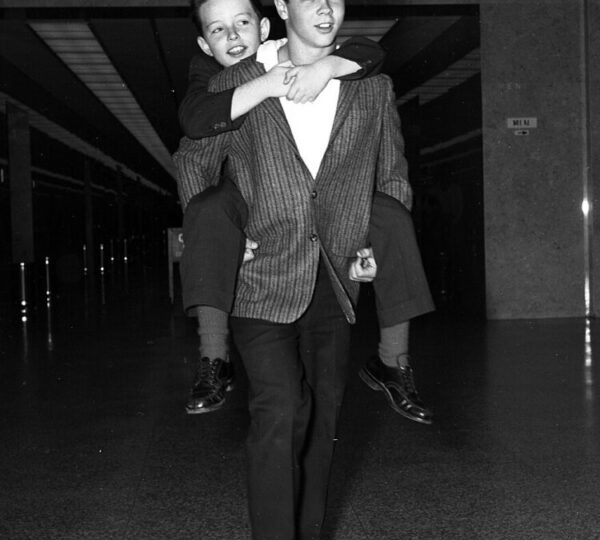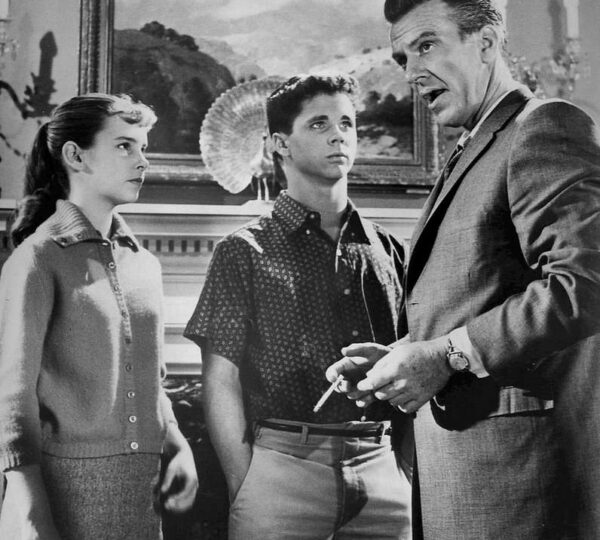The world might indeed be a much better place if more of it mirrored the idealized values shown on Leave It to Beaver. Yet even icons have imperfections, and over its six-year run, Leave It to Beaver had its share of hidden mistakes, production quirks, and behind-the-scenes oddities that many viewers never noticed. Setting a Higher Standard. Unlike many television shows that gradually declined in quality over time, Leave It to Beaver, despite being a fictional portrayal of a family, upheld an unusually high standard for wholesome decency in mid‑20th‑century America.
During its original run from 1957 to 1963, the show won audiences over with its gentle humor, moral tone, and idealistic yet relatable family situations. In short, it was cleverly written, carefully plotted, and often amusing while carrying a sense of sincerity rarely seen in sitcoms of the era. However, as with any longtime production, small errors and curiosities crept in—some so subtle that they are easy to miss without a keen eye. Let’s look into some of the more amusing or surprising ones that slipped past editors and made it into the episodes.
June Cleaver’s Calendar Mistake
One famously overlooked detail involves the calendar hanging on the wall of the Cleaver household. The Cleaver family was always depicted as nearly perfect in their domestic sphere, complete with organization and household order. Yet in the 1963 episode “The Poor Loser,” June Cleaver’s calendar displays the wrong dates—suggesting the prop department may have reused a 1961 calendar rather than updating it for 1963. In that same episode, Beaver and Ward plan to attend a baseball game. On their tickets, the name “Mayfield” appears correctly in large type, but in tiny print is misspelled “Mayfied” — a subtle slip that most viewers would never catch.

The Fake Bee
In the episode “The Silent Treatment,” Beaver is shown painting a door when a bee suddenly hovers around him, creating a comedic moment of surprise. Because using a real bee could be hazardous and difficult to control, the production team employed an artificial bee suspended on a thread. If you look closely, you can sometimes see the thread wobbling around Beaver’s face. It’s a charming example of analogue special effects in the TV era before digital editing.
Jerry Mathers & On-Set Life
Jerry Mathers, who portrayed Theodore “Beaver” Cleaver, has often been asked whether his on-screen persona resembled his off-screen behavior. He once joked, “I got in a lot less trouble,” during his time on the show, noting that there were dozens of crew members watching and around. During breaks, the cast and crew would often play games like baseball or football, creating a kind of extended-family atmosphere on set. Despite the rigorous shooting schedule, this sense of camaraderie softened the pressures of production for the young actor.

The Memorable Audition
Jerry Mathers’ audition for the part of Beaver is the stuff of television lore. He arrived in a Cub Scout uniform (because he had a meeting right after the audition). He admitted to the casting team that he was worried he might miss that meeting. His candor, charm, and innocence impressed the writers Joe Connolly and Bob Mosher immediately, making it clear he was a natural fit for the role—even though, after being cast, he rarely had time to go back and be a Cub Scout.
A Forward-Thinking Contract
Perhaps lesser known is the fact that Jerry Mathers was among the first child actors to negotiate a share of the television show’s merchandise profits. This was a shrewd move—over 60 years later, Leave It to Beaver continues to generate revenue from merchandise, licensing, and reruns. It’s a rare case in which a seemingly simple children’s sitcom holds long-term financial value.

Wally’s Replacement & Casting Quirks
Tony Dow is the actor most associated with the role of Wally Cleaver, but he was not the first. In the pilot episode, Wally was portrayed by Paul Sullivan. Sullivan was later replaced because, strangely enough, he looked too old—he had had a growth spurt that made him appear older than the intended character. This casting tweak helped maintain the youthful family dynamic the producers wanted.
June Cleaver’s Concealed Scar
The actress Barbara Billingsley, who played June Cleaver, was always immaculately dressed—pearls, heels, and perfect composure. But there was a practical reason behind her signature styling: she had a surgical scar at the base of her neck that she preferred not to display on camera. She often used her signature strand of pearls to help conceal it. Additionally, her high heels were not just for style—they helped maintain her height on screen relative to her onscreen children.
Jerry Mathers and Tony Dow’s Friendship
The genuine affection between Jerry Mathers and Tony Dow wasn’t only on-screen—it extended into their real lives. In interviews, Mathers spoke warmly of Dow as a brother figure. After Dow’s passing in 2022, Mathers shared that Wally was not just a TV brother, but a true friend, and that his absence leaves a void in his heart.
The Vietnam Death Rumor
Over the years, various rumors have circulated regarding Jerry Mathers’ life. One persistent falsehood claimed that he died in Vietnam. In reality, Mathers never served overseas. He attempted to enlist in the Marines but was turned down due to concerns about negative press if anything were to happen to him during service. He eventually served in the U.S. Air National Guard instead.
The Most Expensive Episode
On May 5, 1961, Leave It to Beaver aired one of its most memorable and costly episodes. In the plot, Beaver climbs a billboard to prove a giant cup is empty, but ends up falling in. Because Jerry Mathers had a fear of heights, staging this scene was especially challenging and expensive. This episode reportedly cost about $40,000—the highest production cost for the series.
Toilet on Screen
During the 1950s, network censors were extremely restrictive about what could be shown on television, especially regarding bathrooms. Yet Leave It to Beaver managed to become one of the first shows to depict a restroom—though only the tank or back of the toilet was shown. The presence of a toilet tank in episodes was a subtle step forward in realistic set design for TV at the time.
The First Episode Almost Didn’t Air
The pilot episode of Leave It to Beaver nearly never made it to broadcast because it featured both an alligator and a bathroom—two items that were often prohibited by television censors. In that pilot, Wally and Beaver attempt to bring home an alligator, planning to let it live in water—and one draft had it entering a toilet. At the time, depicting a toilet or even showing a bathroom was taboo on television. Eventually, a compromise was reached: the camera would only show the back of a toilet tank. This compromise allowed Leave It to Beaver to push boundaries of what was acceptable on TV.
No Laugh Track, No Overacting
The creators of Leave It to Beaver believed humor should arise naturally from dialogue, character interactions, and situational nuance—not from exaggerated jokes or audience cues. As Tony Dow once explained, “If any line got too much of a laugh, they’d cut it.” The show deliberately avoided laugh tracks and over-the-top comedic gags, giving its humor a quieter, more realistic tone that fit with its wholesome image.
The world might indeed be a much better place if more of it mirrored the idealized values shown on Leave It to Beaver. Yet even icons have imperfections, and over its six-year run, Leave It to Beaver had its share of hidden mistakes, production quirks, and behind-the-scenes oddities that many viewers never noticed. Setting a Higher Standard. Unlike many television shows that gradually declined in quality over time, Leave It to Beaver, despite being a fictional portrayal of a family, upheld an unusually high standard for wholesome decency in mid‑20th‑century America.
During its original run from 1957 to 1963, the show won audiences over with its gentle humor, moral tone, and idealistic yet relatable family situations. In short, it was cleverly written, carefully plotted, and often amusing while carrying a sense of sincerity rarely seen in sitcoms of the era. However, as with any longtime production, small errors and curiosities crept in—some so subtle that they are easy to miss without a keen eye. Let’s look into some of the more amusing or surprising ones that slipped past editors and made it into the episodes.
June Cleaver’s Calendar Mistake
One famously overlooked detail involves the calendar hanging on the wall of the Cleaver household. The Cleaver family was always depicted as nearly perfect in their domestic sphere, complete with organization and household order. Yet in the 1963 episode “The Poor Loser,” June Cleaver’s calendar displays the wrong dates—suggesting the prop department may have reused a 1961 calendar rather than updating it for 1963. In that same episode, Beaver and Ward plan to attend a baseball game. On their tickets, the name “Mayfield” appears correctly in large type, but in tiny print is misspelled “Mayfied” — a subtle slip that most viewers would never catch.

The Fake Bee
In the episode “The Silent Treatment,” Beaver is shown painting a door when a bee suddenly hovers around him, creating a comedic moment of surprise. Because using a real bee could be hazardous and difficult to control, the production team employed an artificial bee suspended on a thread. If you look closely, you can sometimes see the thread wobbling around Beaver’s face. It’s a charming example of analogue special effects in the TV era before digital editing.
Jerry Mathers & On-Set Life
Jerry Mathers, who portrayed Theodore “Beaver” Cleaver, has often been asked whether his on-screen persona resembled his off-screen behavior. He once joked, “I got in a lot less trouble,” during his time on the show, noting that there were dozens of crew members watching and around. During breaks, the cast and crew would often play games like baseball or football, creating a kind of extended-family atmosphere on set. Despite the rigorous shooting schedule, this sense of camaraderie softened the pressures of production for the young actor.

The Memorable Audition
Jerry Mathers’ audition for the part of Beaver is the stuff of television lore. He arrived in a Cub Scout uniform (because he had a meeting right after the audition). He admitted to the casting team that he was worried he might miss that meeting. His candor, charm, and innocence impressed the writers Joe Connolly and Bob Mosher immediately, making it clear he was a natural fit for the role—even though, after being cast, he rarely had time to go back and be a Cub Scout.
A Forward-Thinking Contract
Perhaps lesser known is the fact that Jerry Mathers was among the first child actors to negotiate a share of the television show’s merchandise profits. This was a shrewd move—over 60 years later, Leave It to Beaver continues to generate revenue from merchandise, licensing, and reruns. It’s a rare case in which a seemingly simple children’s sitcom holds long-term financial value.

Wally’s Replacement & Casting Quirks
Tony Dow is the actor most associated with the role of Wally Cleaver, but he was not the first. In the pilot episode, Wally was portrayed by Paul Sullivan. Sullivan was later replaced because, strangely enough, he looked too old—he had had a growth spurt that made him appear older than the intended character. This casting tweak helped maintain the youthful family dynamic the producers wanted.
June Cleaver’s Concealed Scar
The actress Barbara Billingsley, who played June Cleaver, was always immaculately dressed—pearls, heels, and perfect composure. But there was a practical reason behind her signature styling: she had a surgical scar at the base of her neck that she preferred not to display on camera. She often used her signature strand of pearls to help conceal it. Additionally, her high heels were not just for style—they helped maintain her height on screen relative to her onscreen children.
Jerry Mathers and Tony Dow’s Friendship
The genuine affection between Jerry Mathers and Tony Dow wasn’t only on-screen—it extended into their real lives. In interviews, Mathers spoke warmly of Dow as a brother figure. After Dow’s passing in 2022, Mathers shared that Wally was not just a TV brother, but a true friend, and that his absence leaves a void in his heart.
The Vietnam Death Rumor
Over the years, various rumors have circulated regarding Jerry Mathers’ life. One persistent falsehood claimed that he died in Vietnam. In reality, Mathers never served overseas. He attempted to enlist in the Marines but was turned down due to concerns about negative press if anything were to happen to him during service. He eventually served in the U.S. Air National Guard instead.
The Most Expensive Episode
On May 5, 1961, Leave It to Beaver aired one of its most memorable and costly episodes. In the plot, Beaver climbs a billboard to prove a giant cup is empty, but ends up falling in. Because Jerry Mathers had a fear of heights, staging this scene was especially challenging and expensive. This episode reportedly cost about $40,000—the highest production cost for the series.
Toilet on Screen
During the 1950s, network censors were extremely restrictive about what could be shown on television, especially regarding bathrooms. Yet Leave It to Beaver managed to become one of the first shows to depict a restroom—though only the tank or back of the toilet was shown. The presence of a toilet tank in episodes was a subtle step forward in realistic set design for TV at the time.
The First Episode Almost Didn’t Air
The pilot episode of Leave It to Beaver nearly never made it to broadcast because it featured both an alligator and a bathroom—two items that were often prohibited by television censors. In that pilot, Wally and Beaver attempt to bring home an alligator, planning to let it live in water—and one draft had it entering a toilet. At the time, depicting a toilet or even showing a bathroom was taboo on television. Eventually, a compromise was reached: the camera would only show the back of a toilet tank. This compromise allowed Leave It to Beaver to push boundaries of what was acceptable on TV.
No Laugh Track, No Overacting
The creators of Leave It to Beaver believed humor should arise naturally from dialogue, character interactions, and situational nuance—not from exaggerated jokes or audience cues. As Tony Dow once explained, “If any line got too much of a laugh, they’d cut it.” The show deliberately avoided laugh tracks and over-the-top comedic gags, giving its humor a quieter, more realistic tone that fit with its wholesome image.